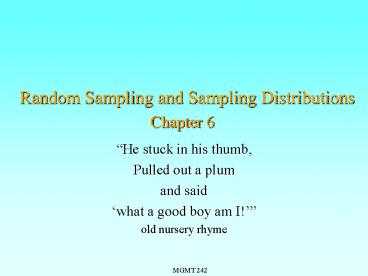Random Sampling and Sampling Distributions Chapter 6 - PowerPoint PPT Presentation
Title:
Random Sampling and Sampling Distributions Chapter 6
Description:
Random Sampling and Sampling Distributions Chapter 6 He stuck in his thumb, Pulled out a plum and said what a good boy am I! old nursery rhyme – PowerPoint PPT presentation
Number of Views:43
Avg rating:3.0/5.0
Title: Random Sampling and Sampling Distributions Chapter 6
1
Random Sampling and Sampling DistributionsChapter
6
- He stuck in his thumb,
- Pulled out a plum
- and said
- what a good boy am I!
- old nursery rhyme
2
Topics and Goals for Chapter 6
- Random Sampling
- Sample Statistics and Relation to Population
Parameters - Sampling Distribution for Sample Mean--
The Central Limit Theorem - Checking Normality-The Normal Probability Plot
- samples from normal distributions
- positively skewed distributions
- negatively skewed distributions
- distributions with outliers
3
Populations and Samples
- A population is a large collection
(theoretically, for the mathematician, infinite)
of the individuals or items of interest (e.g.
consuming public, machine line production items,
etc.) - To measure characteristics of the population we
have to take a sample (smaller number). - If we take a random sample, it is equally likely
that any member of the population will be
included in the sample.
4
Random Sampling
- Sample represents population only if each member
of population equally likely to be included in
sample. - Types of random sampling (see also Chapter 16)
- Simple Random Sampling (SRS)--
- sample whole population
- Stratified Random Sampling
- divide population into groups and sample from
each group for example, in polls, divided
country into four geographical regions and sample
from each - Cluster Sampling
- Divide population into groups and take a sample
of a few groups from the total--e.g., looking at
hospital performance, sample patients in few
hospitals randomly chosen from all hospitals in
the state.
5
Sample Statistics
- Sample Mean xbar (1/N) ? xi , where xbar is
x with a bar over it the sum is taken over all
values of the random variable X
measured in the sample of N units. - xbar is an estimator of the population mean, ?.
- Sample Standard Deviation
s 1/ (N-1) ? (xi-
xbar)2 (1/2 - s is an unbiased estimate of the population
standard deviation, ?. - Note that for large samples (large N), N-1? N
6
Sampling Distribution for Sample MeansThe
Central Limit Theorem--1
- In general (which means almost always), no matter
what distribution the population follows, the
distribution of the sample means follows a
normal distribution with - mean µsample means (for the population of sample
means) equal to µ, the mean for the parent
population, and - standard deviation of the means
?sample means ? /?N. This means that the
larger the sample size, the more accurately we
estimate the mean.
7
Sampling Distribution for Sample MeansThe
Central Limit Theorem-2
- The histogram on the left is for a sample from a
uniform distribution (0 to 100). The sample mean
is 50.2 and the sample standard deviation is 29.3
(?100/?12)
8
Sampling Distribution for Sample MeansThe
Central Limit Theorem-2
- The histogram on the left is for the means of 150
samples, each size 9 (N 9). The average of
these 150 means is 49.4 and the standard
deviation of these 150 sample means is 9.8 which
is about (100/?12?9), the population
standard dev-iation of the mean.
9
Normal Probability Plots (P-plots)
- The procedure to get this plot, which tests
whether data follow a normal distribution
procedure, is the following - 1) order the N data
- 2) assign a rank from 1--the lowest--to N--the
highest value - 3) find the centile score of the mth data point
from the relation centile score m/(N1)--e.g
the 1st data point out of 100 has a fraction
approximately 1/101 lower the 100th data
point has a fraction 100/101 lower - 4) find the z-value (standard normal variate)
corresponding to the centile score (this would
be the z-score or N-score). - 5) plot the observed points versus the z-score
- If the points fall approximately on a straight
line, the distribution is a normal distribution.
10
Normal Probability Plots (P-plots) Examples
- Exam 2 scores were negatively skewed (range
49-100, Q190, median92, Q3 94 - rank ordered value z-score Exam 2
- 1 0.02 -2.10 49
- 2 0.04 -1.80 72
- 3 0.05 -1.61 78
- 4 0.07 -1.47 79
- 5 0.09 -1.35 81
- 6 0.11 -1.24 85
- 7 0.13 -1.15 86
- 8 0.14 -1.07 87
- 9 0.16 -0.99 89
- etc. .
11
Normal Probability Plots (P-plots) Examples
(cont.)
- This Pplot for Exam 2 scores is from the
Statplus addin note that the axes are
inter-changed from the previous (conventional)
order Nscore is y-axis, actual score is x-axis - rank ordered value z-score Exam 2
- 1 0.02 -2.10 49
- 2 0.04 -1.80 72
- 3 0.05 -1.61 78
- 4 0.07 -1.47 79
- 5 0.09 -1.35 81
- etc. .
12
Qualitative Appearance of P-plots































